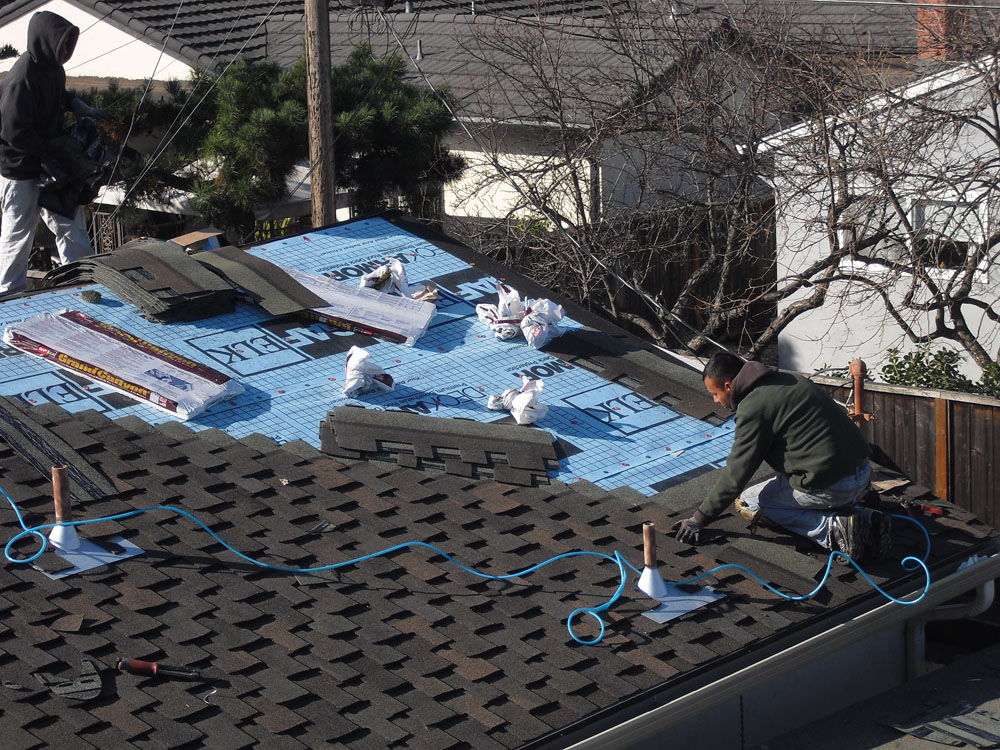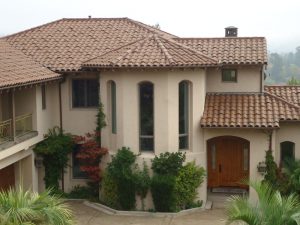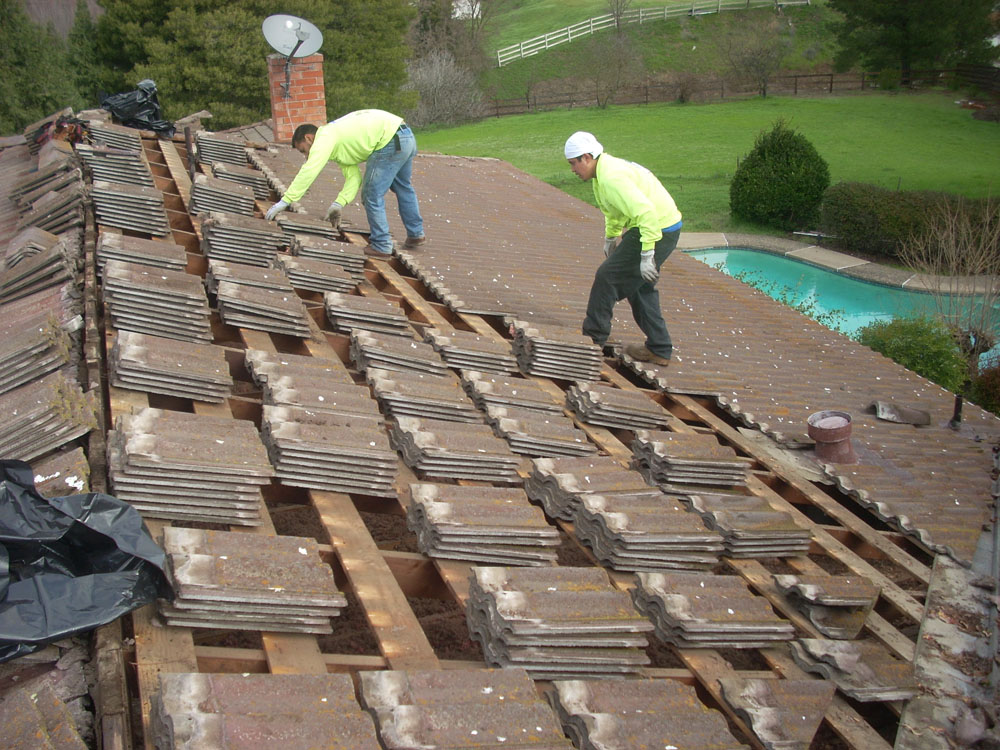
Whether you need a new roof or simply want to perform preventative maintenance, it’s helpful to familiarize yourself with some roofing basics. Photo: Sierra Roofing & Solar (2016)
Like many industries, roofing is more complex than it seems, and it continues to become more so with ongoing technological innovations. This article contains some useful information to help you get more acquainted with the basics of the field, including key terms and answers to frequently asked questions.
COMMON TYPES OF ROOFING MATERIALS
There are numerous roofing materials available, each with its particular pros and cons. Here are some of the most common choices:
Wood shakes and shingles
Wood shakes and shingles blend in well with a natural environment, are easy to repair and replace, and can last 30 to 50 years if maintained properly. However, with the emergence of newer technologies, these natural products are becoming more of a niche option. Although they’re fire-treated at the manufacturing plant, they’re still considered more of a fire hazard than other materials, which is why insurance companies don’t like them and some cities won’t allow them.

Composite shingles offer the look of a natural wood product without the associated functional drawbacks. Photo: Sure Roofing & Waterproofing (2016)
Composite shingles
Composite shingles offer the look of a traditional wood shake roof but are made of asphalt or fiberglass, which makes them naturally fireproof, extremely durable and less expensive than natural wood shakes or shingles.
Built-up roofing (BUR)
Typically used on low-slope roofs, built-up roofing is composed of alternating layers of bitumen (a viscous, tar-like material) and reinforcing fabrics that together create an impermeable membrane. There are a few different types of built-up roofs, including tar and gravel, cap sheet, and modified bitumen. Among its many benefits, built-up roofing offers excellent waterproofing and UV protection.
Tile roofing
Composed of tiles made from concrete or clay, tile roofing is attractive, easy to maintain, fireproof and very durable. While roofing tiles have a reputation for being heavy and breakable, tile manufacturers now make durable, lightweight tiles for residential roofing. In addition, tile is an excellent insulator.

A tile roof can provide a distinctive aesthetic for any home. Photo: Roof-Life Construction (2016)
Metal roofing
Metal roofing (including copper, steel, aluminum and tin roofs) is becoming a more popular choice among today’s homeowners. While it can be expensive to install, metal roofing is very durable and has a long lifespan—at least 50 years in most cases. It’s also lightweight and comes in a wide variety of colors.
Slate roofing
Made of slate rock, slate roofs are durable, fireproof, weather-resistant and aesthetically unique. Synthetic slate roofing materials are also available, which are generally lighter, easier to install and less expensive than genuine slate roofing.
ANATOMY OF A ROOF
Learning about your roof’s various components will give you a better understanding of your roof as a whole and how it functions. Here are some key features to know:
Fascia
Roof fascia is horizontal trim at the eaves that covers the rafter ends. It runs horizontally across the ends of the roof rafters to form the edge of the roof. Fascia is placed above the soffit and below the roofline.
Soffit
Soffit is the exposed, finished underside of overhanging roof eaves. It bridges the space between the siding and the roofline and can be vented to cool the attic space.
Flashing
Usually made of metal sheeting or roll roofing, flashing is installed to prevent rainwater from leaking into a building around joints or vents, pipes, chimneys, walls, dormers and roof valleys. Most roof flashing is made of galvanized steel.
Shingles
Overlapping pieces set on a roof to protect it from the elements
Truss
Supports the weight of the roof framing and decking
Underlayment
Underlayment is the first layer of waterproofing materials that goes on before the shingles or roofing materials. Typically, it’s a roll of asphalt-saturated paper or fiberglass that acts as a protective barrier against moisture and air transmission.
Valley
The inward angle formed by the intersection of two converging roof planes

There are numerous components that go into building a quality roof. Photo: Sierra Roofing & Solar (2016)
FREQUENTLY ASKED QUESTIONS
Consult the following section to find answers to common questions about roofing:
Q: How do I know whether I need a new roof or just repairs?
A: A good roofing contractor will inspect your roof and help you decide whether roofing repairs or a new roof is the best solution. Smaller areas of damage and minor leaks may be fixed with simple roof repairs. Extensive missing or damaged shingles, rotting roof boards, high energy bills, water stains on interior ceilings and walls, or large roof leaks may indicate a roof replacement is needed.
Q: What’s a roofing system?
A: The term “roofing system” refers collectively to the various elements that make up a modern roof, from shingles and underlayment to flashing and ventilation. By working together, these elements form a system that helps ensure long-term durability. Since roofing systems substantially increase roof lifespan, manufacturers are able to offer extended warranties on roofs built in accordance with their system-based specifications.
Q: When is the best time of year to have my roof worked on?
A: Roofers tend to be busiest in late summer through the fall, during which time rates may be higher due to the increased demand. For this reason, spring is a good time to schedule your roofing project. Since roofing companies aren’t as busy, you’re more likely to get the contractor you want, as well as lower prices and better service.
Q: Are there eco-friendly roofing materials and methods I can choose?
A: Yes. From Green roofs (roofs that are partially or completely covered with vegetation) and composite shake roof shingles to recycled shingles and metal roofing, there are many eco-friendly roofing options your roofer can offer. There are also ways to make the installation of your roof more environmentally-friendly. For example, some roofing contractors dispose of old roofing shingles and materials in a more eco-sensitive way, so be sure to ask about this.
Q: How can I maintain my roof?
A: Regular maintenance is important for achieving the full lifespan of a roof. Once your roof hits its 10-year mark, plan to have it professionally inspected every three to five years—that way, you can spot and address problems before they become serious. Another important aspect of maintenance is addressing your home’s rain gutters and downspouts. When gutters and downspouts become clogged, it can result in costly damage, so be sure to check them regularly, remove debris and flush them with a hose to ensure proper functioning.
Q: Why should I choose a Diamond Certified roofing contractor?
A: Diamond Certified helps you choose a roofer with confidence by offering a list of top rated, local companies that have passed the most in-depth rating process in the country. Only local roofing companies rated Highest in Quality and Helpful Expertise earn the prestigious Diamond Certified award. American Ratings Corporation also monitors every Diamond Certified company with in-depth and ongoing research and ratings. Plus, your purchase is backed by the Diamond Certified Performance Guarantee. Overall, you’ll feel confident choosing a Diamond Certified roofing company.
